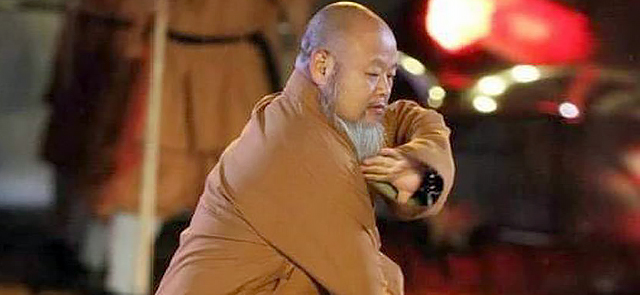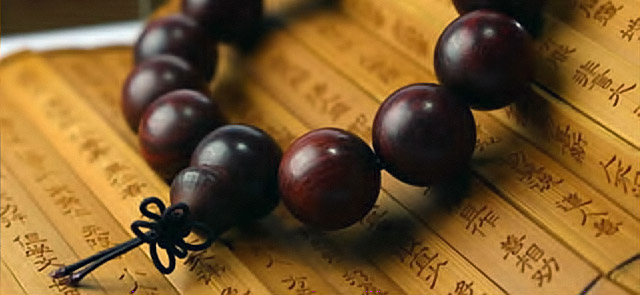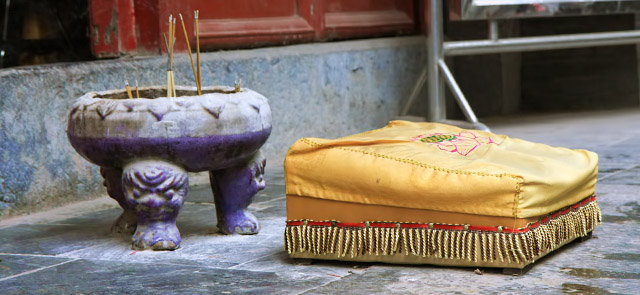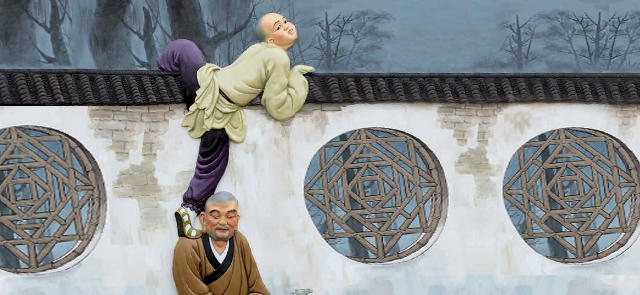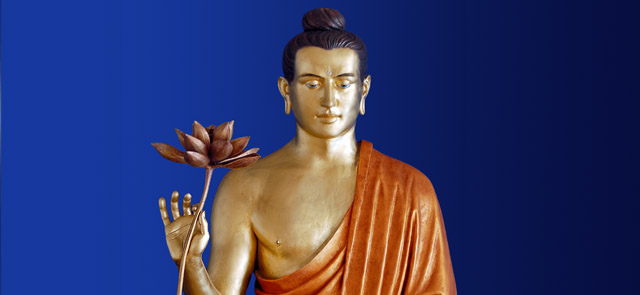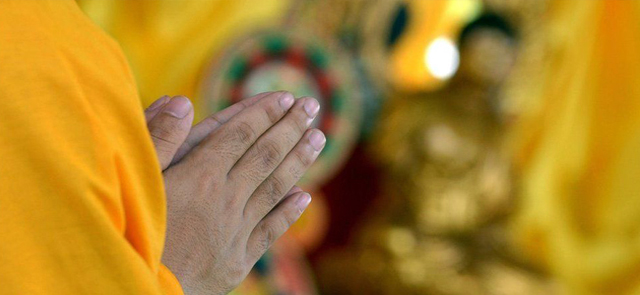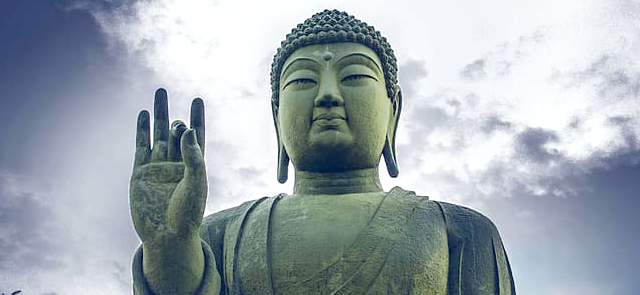Shaolin Rouquan [Chin.: Shàolín Róu Quán 少林柔拳], the ancient martial art form, encompasses a set of internal principles that are crucial to its practice. Once an individual has mastered the correct posture, they can delve into these internal aspects to deepen their understanding and enhance their skills. The following are ten fundamental principles of Shaolin Rouquan:
1. Circular and Spiraling Movement
All movements in Shaolin Rou Quan, follow a circular and spiraling pattern. By turning the waist from side to side, the practitioner generates centripetal and centrifugal forces that flow through the body. This results in the wrists and hands spiraling inwards (Yin) and outwards (Yang). The entire body, including the torso and joints, moves in a spiraling and twisting manner, resembling a flowing river. The energy spirals up and down around the arms, legs, and torso, even during punches which exhibit a slight corkscrew action. Whether performed slowly or rapidly, these movements resemble a whirlpool or a whirlwind. During Fa Jin [Chin.: fājìn 發勁] explosive movements, practitioners become a cyclone of spiraling power, outwardly manifesting an unstoppable force while remaining calm at the center.
2. Slowness and Smoothness
Beginners of Shaolin Rouquan practice it slowly to develop continuous, smooth, and flowing movements. This gentle pace encourages the flow of qi [Chin.: Qì de liúdòng 氣的流動], promoting healing within the body. To cultivate this flow, practitioners can go through the Shaolin Rou Quan form three times: once at regular speed, the second time at half the speed, and the third time at half that speed. Eventually, the movements become so slow and energized that it feels like walking on the moon. The integration of slow, flowing movements (Yin) and explosive Fa Jin movements (Yang), helps maintain balance within the body. The continuous smoothness and slow pace of the movements facilitate a meditative state, making it easier to program the subconscious mind with the Shaolin Rou Quan moves and their self-defense applications. Additionally, practicing slowly allows the development of the ability to perform the movements without muscle tension, thereby enabling effective Fa Jin. Performing Fa Jin without relaxation can lead to muscle tears.
3. Relaxation and Sinking - Sung [Chin.: song 松]
"Sung" refers to the release of unnecessary tension from both the body and mind, allowing relaxation and sinking into the Shaolin Rou Quan posture. Letting go of physical tension facilitates the release of mental tension. When the body is relaxed, supple, and elastic, it becomes more receptive to qi (energy) and Jin (internal power). A state of sung enables practitioners to be at ease, alert, calm, and focused. To achieve sung, one must first release tension in the shoulders, allowing them to sink down and slightly forward. Next, the tensed chest should relax and sink down, followed by the release of the clenched jaw and even a gentle smile. Finally, the tensed belly should relax and expand, allowing the gathering of qi in the lower abdomen. Moving without tension is vital, as tension restricts the flow of blood and chi, resulting in slow and clumsy movements. Although the muscles remain relaxed, all tendons in the body should be slightly flexed.
Contrary to the common belief that good posture involves shoulders back, chest out, and belly in like a soldier, sung promotes a different alignment: shoulders forward, chest in, and belly out. This alignment brings the center of gravity lower, providing physical and mental stability and balance.
4. Rooting – Gen [Chin.: gēn 根]
Rooting originates from the lower half of the body and its connection with the ground. Developing a strong power base in the lower body allows for the transfer of internal force to the upper body. Physically sinking the body weight and focusing it mainly in the lower belly and legs, rather than the chest and head, aids in developing rooting. By gripping the ground with the feet and pushing the legs against the ground and each other, practitioners can shift their body weight from leg to leg. This shifting of weight causes one leg to expand while the other compresses, akin to springs that store and release coiled energy. It is essential to avoid allowing the body to rise up during weight shifts, as it dissipates the generated internal power. Pushing from the legs facilitates the turning of the hips, waist, and belly from side to side. Rooting combines several elements: sinking the body weight, clawing the ground with the feet, pushing the legs against the ground, and pushing the legs against each other like strong springs releasing their power.
5. Centrifugal Waist Power – Lixin yaoli [Chin.: Líxīn yāo lì 離心腰力]
Rooting power from the earth and legs is controlled by the waist and belly, which rotate the torso from side to side. This rotation facilitates the transfer of internal force from the lower body to the upper body. Due to the weight and bulk of the waist and belly, this movement generates significant centrifugal and centripetal force. Proper utilization of this force enables practitioners to generate tremendous power within a confined space. During Fa Jin, the vigorous turn and recoil of the waist propel the hands forward and backward with explosive force.
A Shaolin Rou Quan warm-up technique that exemplifies this principle involves standing with feet shoulder-width apart and knees slightly bent. Keeping the upper body relaxed and loose, practitioners turn the waist from right to left while maintaining a level position. The arms are propelled outward by the centrifugal force, exhibiting great power effortlessly.
Incorporating centrifugal waist power into a Shaolin Rou Quan form enhances blood and qi circulation to the extremities without straining the heart. The rotational and twisting movements serve as a massage for the internal organs, increasing their qi and essence. This stimulation encourages the flow of energy through the meridian system, akin to water flowing down a river once released from a reservoir. To develop centrifugal and centripetal waist power, practitioners should move the waist half a second before the rest of the body while performing the entire form slowly. Once this principle is mastered, the hands, feet, and waist appear to move simultaneously. The waist can generate force even without leg push, allowing for Fa Jin in mid-air. At an advanced level, the waist's Fa Jin can move the feet in the same way it moves the hands.
6. Uniting the Lower and Upper Body – [Chin.: Tǒngyī xiàbànshēn hé shàngbànshēn 統一下半身和上半身]
Moving the lower body slightly ahead of the upper body generates significant power. This integration of movements prevents the loss of torque power resulting from disjointed motion. Moving the lower body before the upper body massages the thoracic diaphragm and internal organs.
When the lower and upper body are united, there is little to no delay between the development of internal power in the legs and waist and its release from the hands. Three methods aid in achieving unification: positioning the nose directly above the navel to synchronize head and body movements, coordinating the movements of the elbows with the hips (when the left hip bone moves forward or backward, the left elbow follows suit), and keeping the hands on the center line. The center line is an imaginary line running down the front of the torso from the nose to the navel. Maintaining hand alignment with the center line is vital for self-defense in Shaolin Rou Quan, as it allows practitioners to deflect attacks away from their own center while attacking the opponent's center.
7. Internal Force - Jin
Jin refers to a type of heavy, loose, relaxed, and elastic whole-body power that differs from localized stiff muscle power. To understand Jin, compare the difference between an axeman chopping down a tree and a carpenter hammering a nail. The axeman utilizes his entire body in an integrated manner, employing waist rotation, leg power, and arm coordination in each stroke. Conversely, the carpenter relies solely on arm strength for each strike.
In Shaolin Rou Quan practice, it is crucial to relax the muscles to allow unimpeded qi flow throughout the body, nourishing the tendons. Jin originates from the development of elasticity and resilience in the tendons, which connect the muscles to the bones, as well as the sinews, which connect the bones within the joints. By fostering relaxation in the muscles, qi is attracted to the flexible and strong tendons, creating a lattice-like network extending from the fingertips to the toes and the top of the head. The entire body becomes a unit of dynamic, elastic power.
Jin bestows Shaolin Rou Quan self-defense techniques with enhanced power. The formidable force delivered by Shaolin Rou Quan practitioners in Fa Jin palm strikes or punches is a result of their internal force, Jin. Those who retain muscle tension during their movements resemble dead and brittle branches. Conversely, individuals who relax both their muscles and tendons move fluidly like limp grass swaying in the wind. Shaolin Rou Quan aims to cultivate flexibility and resilience, similar to young bamboo that bends with the wind and swiftly rebounds. Developing Jin imparts a spring-like quality to one's step and sustains overall body agility with age.
8. Connection – Lianxi [Chin.: Liánxì 聯繫]
In Shaolin Rou Quan, being connected implies that each part of the body is linked to and moved by the preceding part, creating a wave-like rhythm throughout the body similar to the flowing connection of smoke. Each movement originates from the feet, where they push against the ground, travels up through the legs (which push against each other), rotates the waist, turns the spine, rotates the rib cage, and finally connects to the arms and hands. This wave-like transfer of internal force should flow smoothly and effortlessly through the body.
To foster connection, practitioners can imagine moving their entire body through the air as if underwater. Eventually, movements become seemingly effortless. In beginners, the delay in power transfer is noticeable, but in advanced practitioners, the transfer appears instantanous, with all body parts moving in unison.
9. Avoiding Double Weightiness [Chin.: Bìmiǎn shuāngchóng zhòngliàng 避免雙重重量]
Maintaining dynamic Yin-Yang balance is crucial in Shaolin Rou Quan to prevent movements from becoming double weighted. Double weightiness refers to an unnatural flow akin to water in a canal rather than a river. In Shaolin Rou Quan, every part of the body should be in motion without overextension or underextension. Movements should involve dynamic rotation and twisting in a balanced manner.
Avoiding double weightiness is particularly important in the feet and hands. By emphasizing a dynamic balance, practitioners ensure a harmonious and natural flow in their Shaolin Rou Quan movements.
10. Integration [Chin.: Yītǐ huà 一體化]
Integration entails simultaneously incorporating the ten points of correct posture, the ten internal principles, and the methods of Shaolin Rou Quan practice. It is the culmination of harmonizing all the internal aspects to create a cohesive and unified practice.
By integrating correct posture, internal principles, and practice methods, practitioners achieve a holistic approach to Shaolin Rou Quan. This integration harmonizes the body, mind, and energy, fostering a complete and well-rounded practice.
In conclusion, the ten internal principles of Shaolin Rouquan form the foundation for practitioners to delve into the deeper aspects of this martial art. By focusing on circular and spiraling movements, slowness and smoothness, relaxation and sinking, rooting, centrifugal waist power, unifying the lower and upper body, developing internal force (Jin), cultivating connection, avoiding double weightiness, and achieving integration, individuals can enhance their Shaolin Rou Quan practice and experience the profound benefits it offers.
